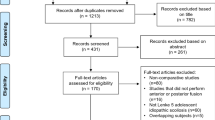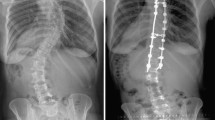Abstract
Study Design
Retrospective cohort study.
Objective
Retrospective comparison of radiographic and clinical outcomes between anterior spinal fusion (ASF) and posterior spinal fusion (PSF) in surgical treatment of Lenke 5 curves.
Summary of Background Data
ASF and PSF are used for treatment of Lenke 5 curves in patients with adolescent idiopathic scoliosis (AIS). Currently, no consensus exists for optimal surgical treatment of Lenke 5 curves.
Methods
Patients with Lenke 5 curves treated with either ASF or PSF were prospectively enrolled in a multicenter database and then retrospectively reviewed. Demographic data, perioperative measures, radiographic data, and SRS-22R scores were collected and compared for statistical significance.
Results
A total of 149 patients were included in the study; 51 underwent PSF and 98 underwent ASF. There was no difference in demographics between groups. The PSF group was fused one level longer than the ASF group (5.9 levels PSF, 4.6 levels ASF, p < .0001). The PSF group had shorter operative times (223 minutes PSF, 297 minutes ASF; p < .0001) and a higher proportion of patients who received a postoperative blood transfusion (45% vs. 5%, p < .0001). PSF patients had longer hospital stays (6.1d PSF vs. 5d ASF, p = .031). The ASF group had larger preoperative major curve (48.2° ASF, 44.2° PSF; p < .01). Coronal balance, thoracolumbar/lumbar Cobb angle, shoulder height, trunk shift, and overall sagittal balance were not different between groups at two-year follow-up. Curve correction at two-year follow-up was similar between groups (66% ASF vs. 62% PSF). There were no significant differences in clinical outcomes or complication rates between groups.
Conclusion
There is no difference in radiographic or clinical outcomes in patients treated with ASF or PSF for Lenke 5 curves. ASF may save a fusion level, but has longer operative time than PSF. Ultimately, the risks and benefits of each approach merit consideration by surgeon and patient.
Level of Evidence
Level II.
Similar content being viewed by others
References
Lenke LG, Betz RR, Haher TR, et al. Multisurgeon assessment of surgical decision-making in adolescent idiopathic scoliosis: curve classification, operative approach, and fusion levels. Spine 2001;26: 2347–53.
Harrington PR. Treatment of scoliosis. Correction and internal fixation by spine instrumentation. J Bone Joint Surg Am 1962;44: 591–610.
Majd ME, Castro Jr FP, Holt RT Anterior fusion for idiopathic scoliosis. Spine 2000 Mar 15;25:696–702.
Kaneda K, Shono Y, Satoh S, Abumi K. New anterior instrumentation for the management of thoracolumbar and lumbar scoliosis. Application of the Kaneda two-rod system. Spine 1996;21:1250–61; discussion 61–2.
Lowe TG, Betz R, Lenke L, et al. Anterior single-rod instrumentation of the thoracic and lumbar spine: saving levels. Spine 2003;28: S208–16.
Wang Y, Fei Q, Qiu G, et al. Anterior spinal fusion versus posterior spinal fusion for moderate lumbar/thoracolumbar adolescent idiopathic scoliosis: a prospective study. Spine 2008;33:2166–72.
Dobbs MB, Lenke LG, Kim YJ, et al. Selective posterior thoracic fusions for adolescent idiopathic scoliosis: comparison of hooks versus pedicle screws. Spine 2006;31:2400–4.
Liu Y, Li M, Zhu XD, et al. Retrospective analysis of anterior correction and fusion for adolescent idiopathic thoracolumbar/lumbar scoliosis: the relationship between preserving mobile segments and trunk balance. Int Orthop 2009;33:191–6.
Shufflebarger HL, Geck MJ, Clark CE. The posterior approach for lumbar and thoracolumbar adolescent idiopathic scoliosis: posterior shortening and pedicle screws. Spine 2004;29:269–76; discussion 76.
Halm H, Niemeyer T, Link T, Liljenqvist U. Segmental pedicle screw instrumentation in idiopathic thoracolumbar and lumbar scoliosis. Eur Spine J 2000;9:191–7.
Geck MJ, Rinella A, Hawthorne D, et al. Comparison of surgical treatment in Lenke 5C adolescent idiopathic scoliosis: anterior dual rod versus posterior pedicle fixation surgery: a comparison of two practices. Spine (Phila Pa 1976) 2009;34:1942–51.
Hee HT, Yu ZR, Wong HK. Comparison of segmental pedicle screw instrumentation versus anterior instrumentation in adolescent idiopathic thoracolumbar and lumbar scoliosis. Spine 2007;32:1533–42.
Kovac V, Puljiz A, Smerdelj M, Pecina M. Scoliosis curve correction, thoracic volume changes, and thoracic diameters in scoliotic patients after anterior and after posterior instrumentation. Int Orthop 2001;25: 66–9.
Potter BK, Kuklo TR, Lenke LG. Radiographic outcomes of anterior spinal fusion versus posterior spinal fusion with thoracic pedicle screws for treatment of Lenke Type I adolescent idiopathic scoliosis curves. Spine (Phila Pa 1976) 2005;30:1859–66.
Smith JA, Deviren V, Berven S, Bradford DS. Does instrumented anterior scoliosis surgery lead to kyphosis, pseudarthrosis, or inadequate correction in adults? Spine 2002;27:529–34.
Tao F, Wang Z, Li M, et al. A compari son of anterior and posterior instrumentation for restoring and retaining sagittal balance in patients with idiopathic adolescent scoliosis. J Spinal Disord Tech 2012;25:303–8.
Betz RR, Harms J, Clements 3rd DH, et al. Comparison of anterior and posterior instrumentation for correction of adolescent thoracic idiopathic scoliosis. Spine 1999;24:225–39.
Geck MJ, Rinella A, Hawthorne D, et al. Anterior dual rod versus posterior pedicle fixation surgery for the surgical treatment in lenke 5C adolescent idiopathic scoliosis: a multicenter, matched case analysis of 42 patients. Spine Deform 2013;1:217–22.
Lenke LG, Betz RR, Bridwell KH, et al. Spontaneous lumbar curve coronal correction after selective anterior or posterior thoracic fusion in adolescent idiopathic scoliosis. Spine 1999;24:1663–71; discussion 72.
Li M, Ni J, Fang X, et al. Comparison of selective anterior versus posterior screw instrumentation in Lenke 5C adolescent idiopathic scoliosis. Spine 2009;34:1162–6.
Nohara A, Kawakam N, Saito T, et al. Comparison of surgical outcomes between anterior fusion and posterior fusion in patients with AIS lenke type 1 or 2 that underwent selective thoracic fusion—long-term follow-up study longer than 10 postoperative years. Spine 2015;40:1681–9.
Rhee JM, Bridwell KH, Won DS, et al. Sagittal plane analysis of adolescent idiopathic scoliosis: the effect of anterior versus posterior instrumentation. Spine 2002;27:2350–6.
Barsi J, Caprio B, Garg S, et al. Do intraoperative LIV-tilt and disk angle remain stable at 2-year follow-up compared with upright radiographs in patients with idiopathic scoliosis?: a retrospective cohort study. J Spinal Disord Tech 2015;28:264–9.
Cho RH, Yaszay B, Bartley CE, et al. Which Lenke 1A curves are at the greatest risk for adding-on... and why? Spine 2012;37:1384–90.
Dobbs MB, Lenke LG, Kim YJ, et al. Anterior/posterior spinal instrumentation versus posterior instrumentation alone for the treatment of adolescent idiopathic scoliotic curves more than 90 degrees. Spine 2006;31:2386–91.
Green DW, Lawhorne 3rd TW, Widmann RF, et al. Long-term magnetic resonance imaging follow-up demonstrates minimal transitional level lumbar disc degeneration after posterior spine fusion for adolescent idiopathic scoliosis. Spine 2011;36:1948–54.
Li J, Hwang SW, Shi Z, et al. Analysis of radiographic parameters relevant to the lowest instrumented vertebrae and postoperative coronal balance in Lenke 5C patients. Spine 2011;36:1673–8.
Marks M, Newton PO, Petcharaporn M, et al. Postoperative segmental motion of the unfused spine distal to the fusion in 100 patients with adolescent idiopathic scoliosis. Spine 2012;37:826–32.
Matsumoto M, Watanabe K, Hosogane N, et al. Postoperative distal adding-on and related factors in Lenke type 1A curve. Spine 2013;38:737–44.
Miyanji F, Pawelek JB, Van Valin SE, et al. Is the lumbar modifier useful in surgical decision making? Defining two distinct Lenke 1A curve patterns. Spine 2008;33:2545–51.
Suk SI, Lee SM, Chung ER, et al. Determination of distal fusion level with segmental pedicle screw fixation in single thoracic idiopathic scoliosis. Spine 2003;28:484–91.
Sweet FA, Lenke LG, Bridwell KH, et al. Prospective radiographic and clinical outcomes and complications of single solid rod instrumented anterior spinal fusion in adolescent idiopathic scoliosis. Spine 2001;26:1956–65.
Wang Y, Hansen ES, Hoy K, et al. Distal adding-on phenomenon in Lenke 1A scoliosis: risk factor identification and treatment strategy comparison. Spine 2011;36:1113–22.
O’Brien MF, Kuklo TR, Blanke RN, Lenke LG. Spinal deformity study group radiographic measurement manual. Memphis, TN: Medtronic Sofamor Danek; 2004.
Adobor RD, Rimeslatten S, Keller A, Brox JI. Repeatability, reliability, and concurrent validity of the scoliosis research society-22 questionnaire and EuroQol in patients with adolescent idiopathic scoliosis. Spine 2010;35:206–9.
Bago J, Perez-Grueso FJ, Les E, et al. Minimal important differences of the SRS-22 Patient Questionnaire following surgical treatment of idiopathic scoliosis. Eur Spine J 2009;18:1898–904.
Carreon LY, Sanders JO, Diab M, et al. The minimum clinically important difference in Scoliosis Research Society-22 Appearance, Activity, and Pain domains after surgical correction of adolescent idiopathic scoliosis. Spine 2010;35:2079–83.
Lubicky JP, Hanson JE, Riley EH. Spinal Deformity Study Group. Instrumentation constructs in pediatric patients undergoing deformity correction correlated with Scoliosis Research Society scores. Spine 2011;36:1692–700.
Wu W, Liang J, Du Y, et al. Reliability and reproducibility analysis of the Cobb angle and assessing sagittal plane by computer-assisted and manual measurement tools. BMC Musculoskelet Disord 2014;15:33.
Lowe TG, Alongi PR, Smith DA, et al. Anterior single rod instrumentation for thoracolumbar adolescent idiopathic scoliosis with and without the use of structural interbody support. Spine 2003;28: 2232–41; discussion 41–2.
Lowe TG, Enguidanos ST, Smith DA, et al. Single-rod versus dualrod anterior instrumentation for idiopathic scoliosis: a biomechanical study. Spine 2005;30:311–7.
Lowe TG, Peters JD. Anterior spinal fusion with Zielke instrumentation for idiopathic scoliosis. A frontal and sagittal curve analysis in 36 patients. Spine 1993;18:423–6.
Turi M, Johnston 2nd CE, Richards BS. Anterior correction of idiopathic scoliosis using TSRH instrumentation. Spine 1993; 18:417–22.
Okada E, Watanabe K, Pang L, et al. Posterior correction and fusion surgery using pedicle-screw constructs for Lenke type 5C adolescent idiopathic scoliosis: a preliminary report. Spine (Phila Pa 1976) 2015;40:25–30.
Author information
Authors and Affiliations
Corresponding author
Additional information
Author disclosures: CO (none); NM (none); XP (none); JE (other from Synthes, Medtronics, and the Journal of Children’s Orthopedics, outside the submitted work); SG (personal fees from Decision Support in Medicine, Medtronic, and Mighty Oak Medical; other from Pediatric Orthopaedic Society of North America, Scoliosis Research Society, and US News & World Report Best Children’s Hospitals Orthopedics Working Group, outside the submitted work); ME (other from the Pediatric Orthopaedic Society of North America, personal fees from Biomet, outside the submitted work).
All of the data for the present study were obtained via the SDSG, which was directly supported by Medtronic as a corporate sponsor.
Rights and permissions
About this article
Cite this article
O’Donnell, C., Michael, N., Pan, X. et al. Anterior Spinal Fusion and Posterior Spinal Fusion Both Effectively Treat Lenke Type 5 Curves in Adolescent Idiopathic Scoliosis: A Multicenter Study. Spine Deform 6, 231–240 (2018). https://doi.org/10.1016/j.jspd.2017.09.054
Received:
Revised:
Accepted:
Published:
Issue Date:
DOI: https://doi.org/10.1016/j.jspd.2017.09.054




